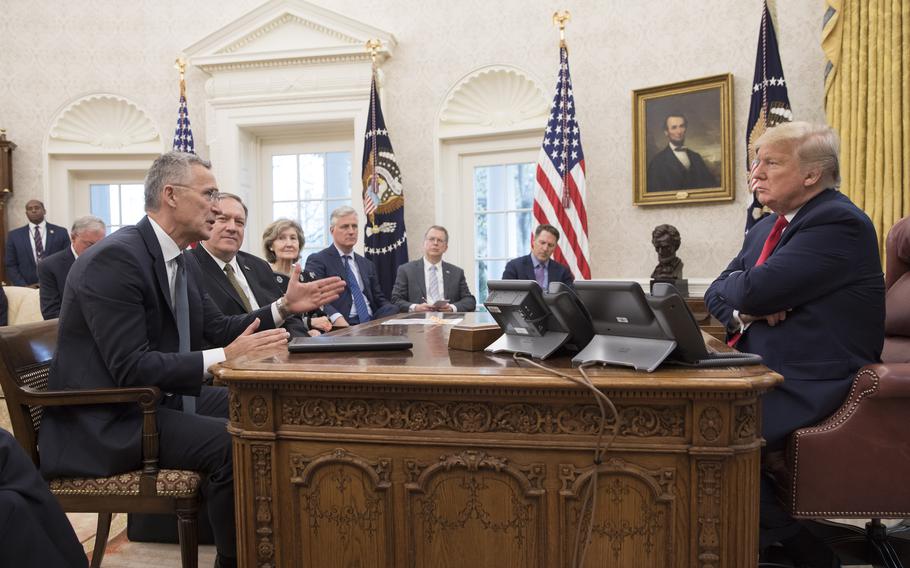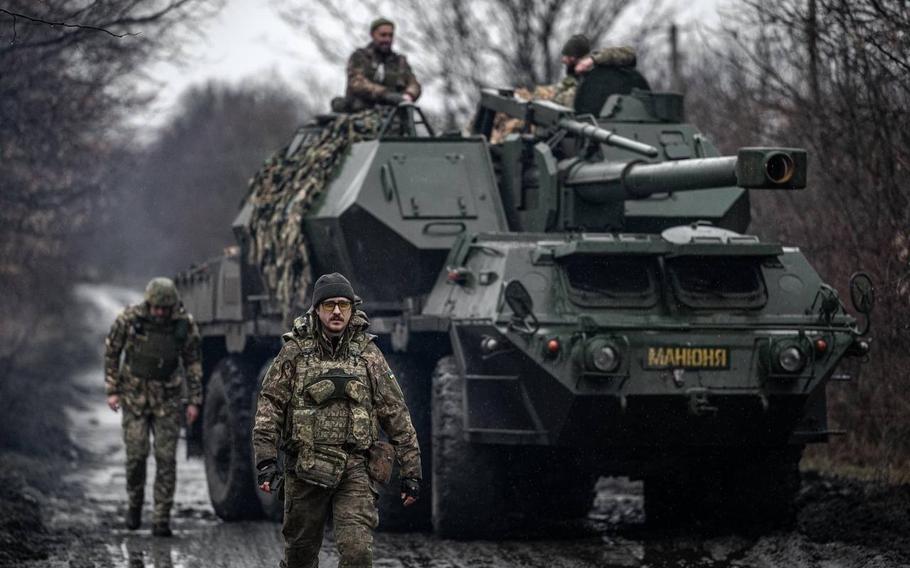
NATO Secretary-General Jens Stoltenberg, left, meets with then-President Donald Trump at the White House in 2019. During a campaign speech Feb. 10, 2024, Trump said he would encourage Russia to attack NATO allies that aren't spending enough on their own defense. (NATO)
Former President Donald Trump’s statement over the weekend that he would encourage Russia to attack NATO allies that don’t spend enough on defense exposes critical vulnerabilities that a second Trump term would bring for the 75-year-old alliance.
At a campaign event Saturday in South Carolina, Trump repeated his long-held view that American willingness to defend NATO members hinges on whether they’re “delinquent” on defense spending.
But his invitation to Russia took things a step further this time.
“No, I would not protect you,” Trump said he once told an unidentified European head of state. “In fact, I would encourage (the Russians) to do whatever the hell they want. You’ve got to pay. You got to pay your bills.”
Trump’s erroneous insistence that certain allies are “delinquent” and his refusal to commit to NATO’s linchpin provision, that an attack on one is an attack on all, would call the feasibility of a U.S.-led NATO into question in the event he is reelected.
Could Trump withdraw the U.S. from NATO?
Trumps’ frequent criticism of NATO has fueled speculation about whether he would seek to pull the United States out of the alliance. No country in NATO’s 75-year history has ever attempted such a thing.
However, there is an alliance mechanism for getting out if a country so chooses. Under Article 13, a one-year notice is required.
With Trump in mind, U.S. lawmakers have sought to make that more difficult. Last year’s defense funding bill included a provision that forbids a president from pulling out of the alliance without congressional approval.
Formal withdrawal could hinge on congressional support for NATO, which has traditionally been bipartisan. Still, a president could challenge the constitutionality of that law in the courts.
Is the U.S. required to defend allies that are attacked?
Trump’s ambivalence about defending all allies could undermine NATO’s viability even without an American pullout. The organization’s very essence is that an attack on one is an attack on all.
Traditionally, that has been understood to mean that if one ally is invaded, the attacker would face the collective force of all members.
But NATO’s Article 5 provision doesn’t mandate that kind of a response. Each member of the alliance “will take the actions it deems necessary to assist the Ally attacked,” it states.
Trump’s comments about encouraging Russia underscore the potential fragility of the collective mutual defense assurance.
NATO leader Jens Stoltenberg immediately rebuked Trump, warning that any suggestion that its allies do not defend one another “puts American and European soldiers at increased risk.”
In Europe, Trump’s latest critiques have renewed a sense of angst that had subsided under President Joe Biden, who frequently states that the U.S. will defend “every inch” of NATO territory.
Numerous analysts have said Trump’s words should serve as a call to action in Europe’s capitals.
“This statement should motivate Europeans to invest more in defense with a double purpose: to make NATO Trump-proof if possible and to prepare for a post-NATO Europe,” Ulrich Speck, a prominent German security analyst, said in a statement Sunday. “Handwringing not sufficient.”
What are NATO’s spending rules?
At the heart of Trump’s complaints about NATO is the reality that many alliance members don’t meet agreed-on defense spending benchmarks.
But his rhetoric has created confusion about the rules. He has frequently said allies aren’t making their NATO “payments” and are either “delinquent” or in arrears on their “dues.”
However, NATO members do not pay dues. The crux of the issue is that countries don’t invest enough in their own militaries.

In an undated photo, Ukrainian soldiers move a self-propelled Dana howitzer donated by the Czech Republic during combat operations in Ukraine. In 1999, the Czech Republic was one of three former members of the Warsaw Pact to join NATO. (Ukrainian Ministry of Defense/X)
The defense spending threshold is set at 2% of gross domestic product.
Since the Russian invasion of Ukraine almost two years ago, though, Stoltenberg and other NATO leaders have said over and over that 2% is the bare minimum now.
The point is for all members to invest enough to ensure fair burden-sharing and sufficient capability when it comes to the collective defense of members.
Currently, only about 10 of 31 members hit the 2% target. Germany, Europe’s economic powerhouse, is among the countries that consistently fall short.
For that reason, many of Trump’s attacks have centered on Germany, which hosts more than 30,000 U.S. troops.
While NATO countries have steadily increased defense spending since Russia’s initial invasion of Ukraine in 2014, it’s unclear when all allies will hit the mark.